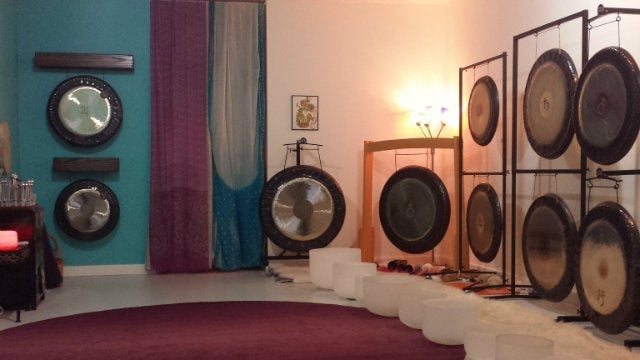Turns out “sound healing” can be actually, well, healing
Los Angeles


Los Angeles
“I heard a gong for the first time 15 or 16 years ago,” says Jamie Ford.
She’d heard a gong strike before, obviously—“I’d seen the Gong Show”—but this gong, in a 2000 kundalini yoga class, was the first one she’d ever heard.
“I heard it and I was just—I went to another place,” Ford tells Quartz. “I was calm. I could travel. Everything just expanded.”
At the time, Ford was a biologist studying the desert tortoise. The gong marked the start of a new career path, one that led to a room in LA’s Glassell Park neighborhood filled with crystals, tuning forks, and 12 brass-hued gongs the size of big-rig tires.
Ford, 39, is a sound healer and owner of the Sound Space. In 30 minutes her year-old studio, will fill with 10 strangers who will lie on the floor while the vibrations of her improvised gong concert wash over them. Ford also does private sessions. About 75% of the people who come to her are dealing with anxiety, stress, and depression.

Sound healing adherents say that listening to percussive instruments like gongs, Tibetan singing bowls, and tuning forks reduces stress and can place the listener in a meditative state. Practitioners offer their services as an alternative treatment for problems like anxiety, chronic pain, sleep disorders, and PTSD.
Sound healing is having a moment. There are sound healing Meetups in LA, London, and Chicago. More than 5,000 people are listed in the member directory of the Boulder, Colorado-based Sound Healers Association. The LA Times listed one of Ford’s sound baths in its annual holiday gift guide.
But are the benefits of sound therapy real? Or is this a particularly noisy form of quackery?
Planets versus peer review
Evidence of using sound, music, and chants to heal the sick dates back thousands of years to ancient Egyptians and Australia’s Aborigines.
Today, a Google search for “sound healing” yields websites with auto-play music and a lot of celestial-themed clip art. It’s not a regulated industry, though several associations offer correspondence certification courses with modules like ”The Sound of Love” and “How to Achieve Dominant Outward Radiation.”
The sound scene has a quintessentially LA, New Age-y vibe to it, a feeling bolstered by the fuzzy explanations practitioners offer for why, exactly, the clang of a gong has therapeutic effects on a human body.
Ford plays gongs whose makers claim to have specifically tuned them to the orbital properties of the planets. Some practitioners say the right sound unblocks or redirects energy in the body, similar to the claims of acupuncture. Others say the sound works in tandem with humans’ own vibrational frequencies, or that it rearranges the ions on cell membranes.
These claims don’t stand up to scientific scrutiny.
I spoke to Chris Kyriakakis, a professor of audio signal processing at the University of Southern California’s Viterbi School of Engineering. Among Kyriakakis’s areas of study is how the human brain translates sound waves into perceptible sounds.
“There’s no scientific published peer reviewed paper that supports any of these claims,” he said.
“These are all cool claims. It would be nice if some of them were true. But there’s no science whatsoever that supports any of these claims.”
OK, so sound healers’ theories about why their practices make people feel better don’t stack up. But science has looked at the question of whether people do in fact feel better after hearing certain sounds, and on this, there is some evidence.
Music is a known de-stressor. Scientists from the National Institutes of Health found that subjects who listened to classical music before a stressful event recovered from the stress faster than those who listened to rippling water or simply relaxed in quiet.
But producing sound, particularly the deep, resonant kind sound therapy works with, may be even more beneficial than passively listening to it. A 2012 study split 39 people caring for family members with dementia into two groups. One was tasked with listening to relaxing music for 12 minutes each day for eight weeks. The other used the same amount of time to practice kirtan kriya, a meditative form of yoga that involves chanting.
At the end of the study the group that listened to relaxing music felt good, with 31.2% reporting substantial improvement in depressive symptoms and 19% scoring higher on a mental health survey. But the chanting group felt better, with 65.2% reporting fewer depressive symptoms and 52% reporting better mental health scores.
The study sample is small. But lead author Helen Lavretsky, a professor of psychiatry at UCLA, told Quartz that sound has interesting implications for treating chronic stress and memory problems. Lavretsky is also a fan of sound healing, having experimented with gongs, Tibetan singing bowls, and chanting. (Ford sometimes has clients in private sessions chant as part of their therapy.)
One of sound healing’s biggest mainstream advocates was the late Mitchell Gaynor, an oncologist and clinical assistant professor at Weill Cornell Medical College in New York and director of medical oncology at the school’s Center for Integrative Medicine. (Gaynor died in September.)
Gaynor encouraged sound therapy alongside conventional medicine, arguing that relaxed patients have lower stress hormones, stronger immune systems, and better tools to cope with the psychological and physical effects of their disease and treatment.
Gaynor was turned on to sound healing in the early 1990s, when a Tibetan patient gifted him a traditional singing bowl.
“If somebody had told me when I was a medical student in Dallas, Texas, that one day I would be teaching my patients to use singing bowls to heal themselves, I would have thought he or she was crazy,” Gaynor wrote in the 1999 book The Healing Power of Sound.
“Is it normal to have orgasms?”
There is no standard response to a sound bath, Ford explains as bathers arrive. Some people report expansive, consciousness-altering experiences. Some cry. Some fall asleep.
“One woman came up to me [after a session] and said, is it normal to have orgasms?” Ford says. “I was like, whoa. I should put that in my marketing materials.”
With this in mind, I find myself sizing up my fellow bathers as they come through the studio door. Fortunately, none of them look like the public-orgasm type, except maybe for the couple two pillows down giggling and kissing softly on a shared mat.
The poncho-clad gentleman next to me is busy arranging a set of crystals he brought from home into a very specific configuration on his mat. I try to start a conversation. He doesn’t want to talk about his crystals.
The friendly-looking blond woman on my other side is more talkative, explaining that she’s come to the session to drop off some emotional baggage. “I just want to get rid of stuff that doesn’t belong to me anymore,” she explains. “And if not, just to have a good time.”
Ford encourages us all to lie down and relax as the sound bath begins. Played together, the gongs create a surprisingly rich and complex sound that evokes the soundtrack of a 1970s sci-fi movie set in space. There’s incense burning. It’s a little trippy.
I close my eyes. My mind wanders. I replay a thing my kid did the other day, and suddenly there’s a childhood memory that hasn’t lit up my amygdala in decades—where did that come from?
I think about space. Then I have what feels like a very deep revelation about a small personal conundrum. Then I think about how my back hurts. After a while I curl up on my side and settle into a pleasant absence of any real thoughts at all, until the music stops and Ford gently instructs us to stretch and wake up.
I don’t feel as if I’ve traveled to a different astral plain, but I feel calm, a feeling that lasts as we bid goodbye and head out into LA traffic, fading slowly like the trailing echo of a gong.